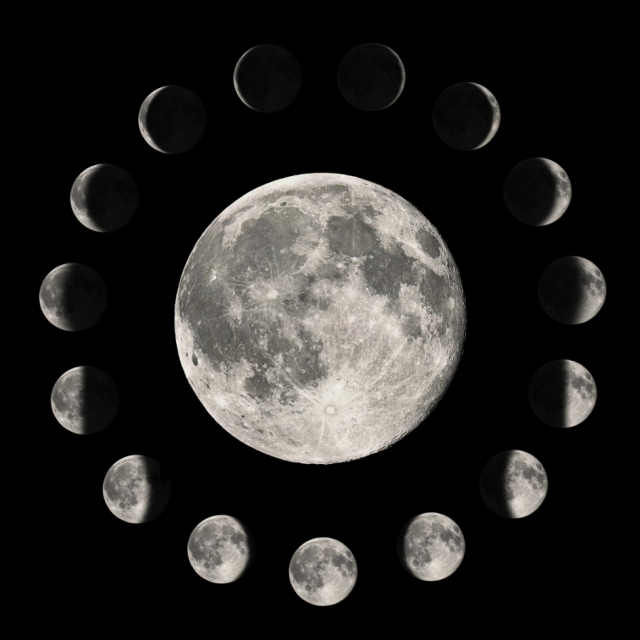The January 2025 lunar calendar offers a fascinating insight into the phases of the moon, which not only guide astronomers and sky watchers but also have a significant impact on cultural traditions, agricultural practices, and the planning of human activities. This article details each lunar phase in January, their exact dates, astronomical significance, and relevance in various contexts.
Understanding lunar phases.
The Moon goes through a cycle of phases as it orbits Earth, and this cycle repeats approximately every 29.5 days. These phases are defined by how sunlight illuminates the Moon's surface, from the perspective of an observer on Earth. January 2025 begins with a first quarter Moon, progressing through the following phases:
- First Quarter : January 6th.
- Full Moon : January 13th.
- Last Quarter : January 21st.
- New Moon : January 29.
Each of these stages has unique characteristics and associated meanings, both in the scientific and cultural fields.
Moon phase details for January 2025.
First Quarter - January 6.
The crescent phase occurs when half of the visible face of the moon is illuminated, with the light growing each night. This stage, which takes place on January 6, is symbolic of growth and progress. It is a good time to begin projects and set goals. Astronomically, the crescent light of the moon improves conditions for observing surface features such as craters and mountains through telescopes.
Sources: FindYourFate and Time and Date .
Full Moon - January 13.
The Full Moon, one of the most anticipated events of the month, will occur on January 13 at 22:24 UTC. During this phase, the entire visible face of the moon is illuminated, providing a dazzling spectacle in the night sky. In many cultures, the full moon is associated with culmination and liberation. It is common to perform rituals to close personal and professional cycles. However, its brightness can make it difficult to observe other celestial bodies.
Sources: Tutiempo and Lunar Calendar .
Last Quarter - January 21.
The last quarter marks the beginning of the decrease in lunar illumination, with only half of it visible. This event occurs on January 21 and is a period associated with introspection, rest, and preparation for new beginnings. Astronomically, this phase favors the observation of deep skies, since the moonlight does not interfere as much with visibility.
Sources: SpaceWeatherLive .
New Moon - January 29.
The new moon is a special time in the lunar calendar. During this phase, which will occur on January 29 at 12:36 UTC, the moon is completely dark, reflecting no sunlight. It is considered an auspicious time to start projects, plant seeds (literally and metaphorically) and set new intentions. The darkness of the new moon is also ideal for astronomical observation of celestial bodies such as stars, galaxies and nebulas.
Sources: FindYourFate and Time and Date .
Cultural impact of lunar phases.
The phases of the moon have influenced humanity since time immemorial. In January, these phases are associated with various rituals and practices:
Spiritual rituals : Many cultures use the full moon and the new moon to meditate, perform gratitude ceremonies or set intentions. For example, the January full moon is known in some traditions as the "Wolf Moon", evoking the connection with nature.
Agriculture : Farmers follow the lunar calendar to optimize their harvests. The waxing moon is ideal for planting crops that grow upwards, while the waning moon is more suitable for roots and tubers.
Fishing : Tides, influenced by lunar gravity, reach their most extreme levels during the full moon and new moon, affecting fishing activities.
Sources: Time and Date and SpaceWeatherLive .
Astronomical importance of the lunar calendar.
In addition to their cultural impact, lunar phases have significant scientific relevance:
- Astronomical observation : The less illuminated phases (last quarter and new moon) are ideal for observing celestial bodies, since moonlight does not interfere with visibility.
- Space missions : Space agencies like NASA and SpaceX often plan missions with lunar phases in mind, especially if they involve studying the lunar surface.
Sources: SpaceWeatherLive and Tutiempo .
How to follow the lunar calendar.
For those who wish to follow the January 2025 lunar calendar in detail, there are various apps and online resources that offer accurate information. These include calendars with schedules adjusted for different time zones, as well as additional data such as the position of the moon in the zodiac and complementary astronomical events.
Consultation recommendations:
The January 2025 lunar calendar is not only an astronomical tool, but also a reflection of how humanity connects with natural cycles. The phases of the moon offer an opportunity to better understand our relationship with the cosmos and with our own lives. Whether it's observing the majesty of a full moon or planning projects during the new moon, January promises to be a month full of possibilities and inspiration guided by the light (and shadow) of our natural satellite.
For more information and updated resources, please refer to the sources listed above.
